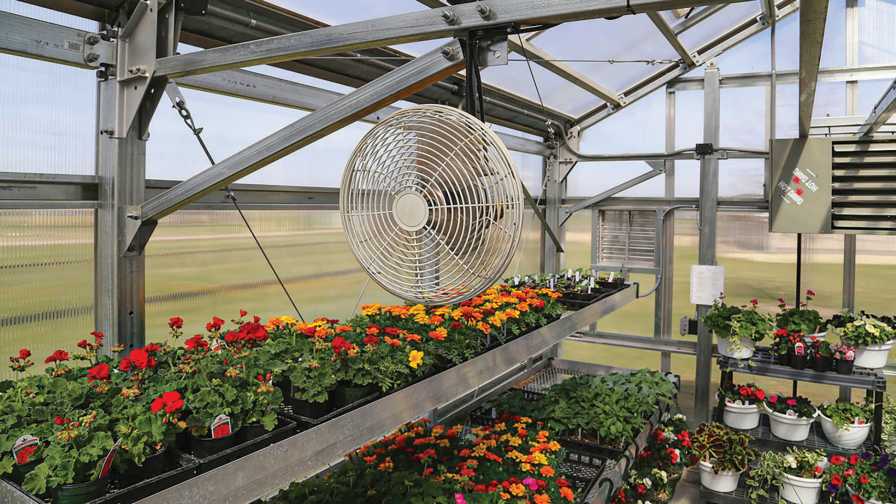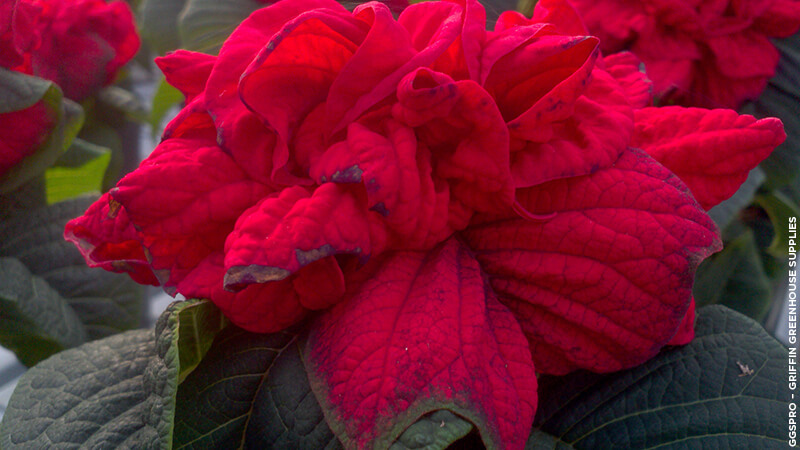How to Create the Ideal Ventilation System for Your Greenhouse

Active cooling in a greenhouse requires mechanical tools such as fans and evaporative coolers to create air exchange.
Photo courtesy of GrowSpan Greenhouses
One of the advantages of growing in a greenhouse is that growers can eliminate factors such as inclement weather, and most pests, while still benefiting from the sun’s natural light and the complete control that indoor growers experience. Greenhouse growers do, however, have to consider ventilation.
Regular air exchange will allow crops to thrive and promote a healthy temperature range. There are several methods, tools, and tactics growers use to achieve proper ventilation, but the best operations often use a combination of both passive and active ventilation. By designing their greenhouses using both methods, growers can effectively ventilate their structures while keeping costs down.
Strategic Ventilation Points
Passive ventilation is a greenhouse grower’s most affordable option, because it largely depends on Mother Nature. More specifically, you can focus on the wind effect and thermal buoyancy to passively ventilate. You can capitalize on the wind effect by just using the wind from outside to flood the structure with fresh air. Thermal buoyancy refers to the fact that hot air rises. So as fresh, cool air enters the structure, stale, hot air is pushed upward.
To take advantage of this, you will need strategic ventilation points on your structure, which can include roll-up sides, roof vents, and wall vents. The wall vents and roll-up sides allow fresh air to easily enter the structure, while the roof vents let the stale air easily exit the space.
But as Will Kacheris, Commercial Greenhouse Specialist for GrowSpan Greenhouse Structures, points out, passive ventilation is beyond a grower’s control.
“Passive ventilation can be used when the situation presents itself, but active ventilation should always be available,” Kacheris says. “For instance, a partially cloudy day with a light breeze is a perfect time to open insect-screened, roll-up walls and let the breeze provide fresh air and cool off the grow. However, you cannot expect to have a commercial production timeline with only passive ventilation. There will be days where it’s not enough, leading to shutdowns and poor crops.”

To take advantage of passive ventilation, growers will need strategic ventilation points on their structures, which can include roll-up sides, roof vents, and wall vents.
Photo courtesy of GrowSpan Greenhouses
Importance of an Active Cooling System
A greenhouse is going to need wind speeds of somewhere between two and three miles per hour to provide the required ventilation. There are many days a year that won’t hit this mark. To combat this, operations will need a well-designed, active cooling system.
Active cooling requires mechanical tools, like fans and evaporative coolers, to create air exchange. These tools require electricity and, therefore, money. So it’s important to have a passive system that can cut costs in place. The best part of active ventilation is that it ensures precision control, making it an important factor in creating the ideal controlled climate.
Fans are an obvious go-to for growers, and they’re extremely effective. One often overlooked piece of equipment is an evaporative cooling wall. It’s especially great for warmer climates because it can bring in fresh air while significantly cooling the growing environment. The wall pulls air through a damp pad, and then fans distribute the cool, moist air. Evaporative cooling walls can easily reduce temperatures by 20°F, and they can also help to reduce the need to water.
Of course, growers may worry about the cost of having an active cooling system in place.
“Costs can vary widely,” Kacheris says. “Operations will need to consider the electrical draw of the exhaust fans, the cooling system pump, the wall vents, and the water consumption of the cooler itself. Balancing the cost of these elements with the yield increase and additional seasonal opportunities is key to determining which system is right. Maximum control is not always the key to success. Instead, analyzing the market, climate, and crop to find what works can lead to higher margins.”
By blending passive with active ventilation, growers get the best of both worlds. While obtaining the control afforded by active systems, operations can turn an active system off when the outdoor environment cooperates, creating a more profitable crop without sacrificing quality.









